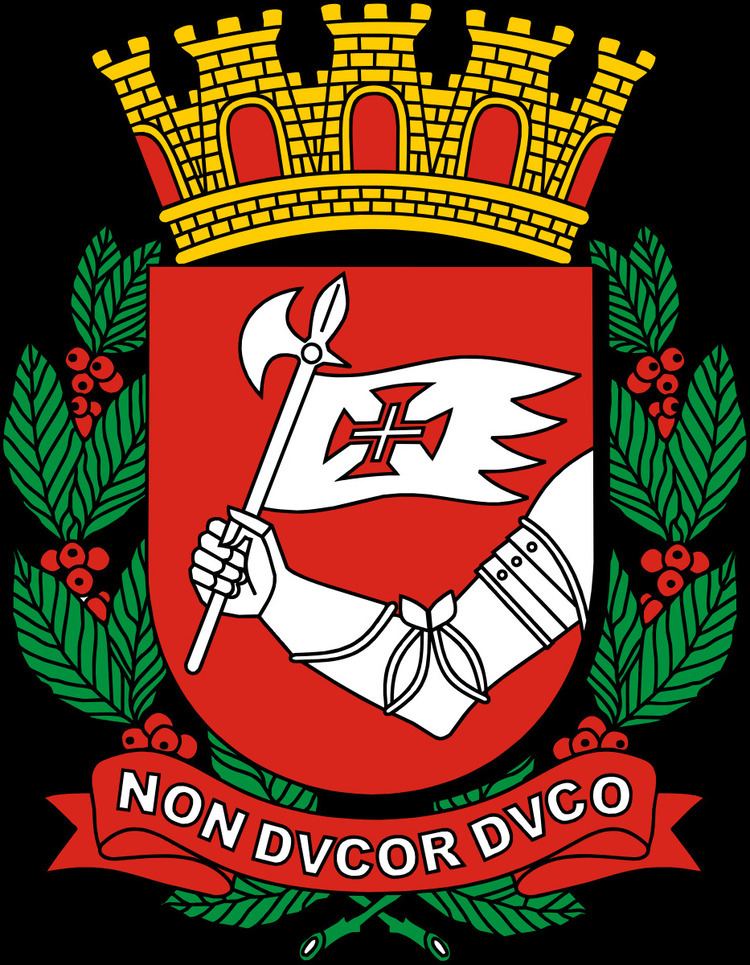 | ||
Quatrocentão (feminine quatrocentona, plural quatrocentões), is a term used to designate members of elite families descendant from the early settlers and explorers of São Paulo. This term was first used in the early 20th century, in the past they were referred to as primeiros povoadores (first settlers) or nobreza da terra (nobility of the land). These families had occupied important positions as governors, military commanders, aldermen and explorers of early colonial South America. They received large land grants from the Portuguese Crown and originated mostly in Portugal and Spain, but some in Flanders and other places in Europe. A portion of the original settlers were noblemen of the Royal House of Portugal. Under the rule of the Habsburgs and the Iberian Union, they were joined by Spanish families, some also of noble origin. The earliest of these settlers married descendants of the Amerindian Chief of Piratininga, Martim Afonso Tibiriçá, and after intermarried frequently among the families in the Genealogia Paulistana, forming an endogamous group. They were first listed in a genealogical study in the 1700s by Pedro Taques de Almeida Paes Leme and last listed in the classical genealogical work Genealogia Paulistana, published in 1905.
Contents
- Meaning of the Term
- Nobreza da Terra
- History
- Timeline
- Geographical presence in Brazil
- Families in the Genealogia Paulistana
- References
The quatrocentões and their ancestors were greatly responsible for the expansion of the Portuguese Empire in South America, at the expense of the Spanish Empire. Also the Brazilian Gold Rush, which had strong repercussion in Europe and in the Americas, the founding of many towns in Minas Gerais such as Ouro Preto, and also the first phase of the Industrialization of São Paulo during the Empire of Brazil. But also for the maintenance of slavery in Brazil, making Brazil the last country in the Americas to abolish slavery in 1888. In the 19th and early 20th century they formed a large portion of the plantation aristocrats and titled nobility of the Empire of Brazil. They became decadent after the financial crisis of 1929, the rise of new wealthy immigrants and the Revolution of 1932, that they lost against Getulio Vargas, ironically a descendant of these early settlers of São Paulo. Quatrocentões are a polarizing group in Brazilian history, praised by some and blamed by others for their actions during the course of Brazilian history.
Although no longer existing as a strong social group, one can still find among modern descendants of the early settlers of São Paulo many businessmen and members of the political elite in Brazil and elsewhere, both left-wing and right-wing. They include presidents of Brazil; Brazilian senators, deputies and governors; the current Royal Family of Sweden; a branch of the princes of Löwenstein-Wertheim-Freudenberg and some members of the House of Orléans (Orléans-Braganza branch).
Meaning of the Term
Quatrocentão is the Portuguese language augmentative for four hundred, implying that these families had been in São Paulo for four hundred years in the beginning of the 20th century, when the term became used to distinguish them from recent European and Middle Eastern (Syrian and Lebanese) immigrants.
Italian writer and journalist Corrado Pizzinelli defined them in the following way in 1955:
...they are something more than a noble, of the “true lord”, of the aristocrat, they are the authors and the censors of the Brazilian Gotha Almanach. They are the holders and dispensers of being Brazilian. For them, the world started four hundred years ago, when the first Portuguese and their families, from which they descend, arrived in Brazil. The quatrocentões are lovable, gentle and proud. They have a strong sense of caste and are inaccessible: they constitute 70 percent of the ruling political class of Brazil, they defend themselves by every way from society.
Nobreza da Terra
The term nobreza da terra, Portuguese for "nobility of the land", was used not only in São Paulo but all over the Portuguese Empire to designate those that had the status of nobility under Portuguese legislation. Beside the fact that they had to live as noblemen, they had to formalize their status by occupying either positions in the Royal Household of Portugal, to have been a knight in the military orders of Portugal, have instituted a majorat, have occupied a position in public administration or to have been a military officer.
History
A number of renowned historians in Brazil had studied the history of the early settlers of S. Paulo and their descendants, including Sérgio Buarque de Holanda, Alfredo Ellis Junior, Caio Prado Júnior, Afonso d'Escragnolle Taunay, Antônio Castilho de Alcântara Machado and Washington Luís Pereira de Sousa. All of them also descendants of these families or married into it.
Timeline
Geographical presence in Brazil
Beside their connection to the state of São Paulo, and given the expansionist nature of the early settlers already in the colonial period, today one can find their descendants in the states of Rio de Janeiro, Paraná, Santa Catarina, Rio Grande do Sul, Goiás, Mato Grosso do Sul, Mato Grosso and Minas Gerais. It has been estimated mathematically that around 15 million Brazilians are descendants of these early settlers (less than 10% of the Brazilian population).
Families in the Genealogia Paulistana
These are only the chapter heads chosen by author Silva Leme for his book Genealogia Paulistana, many other families are part of the book, all of them married into these families listed below, an index can be found in the final book with all the families up to 1905.
